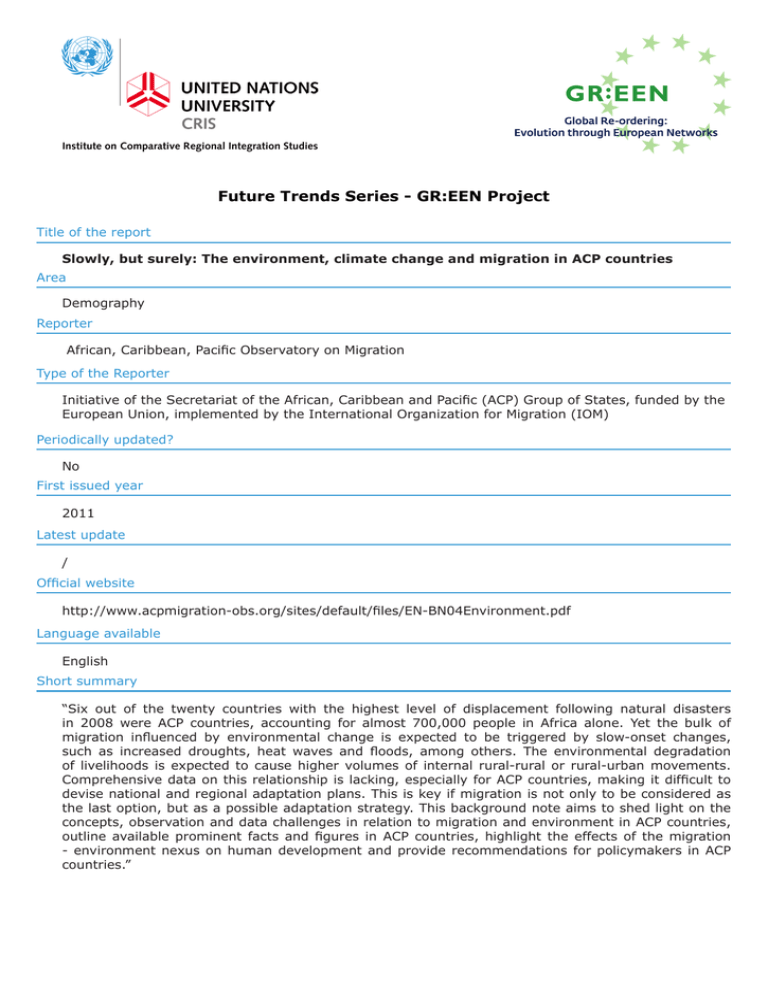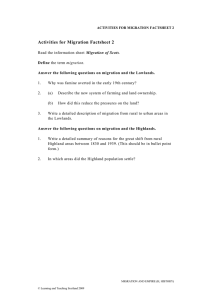Future Trends Series - GR:EEN Project
advertisement

Future Trends Series - GR:EEN Project Title of the report Slowly, but surely: The environment, climate change and migration in ACP countries Area Demography Reporter African, Caribbean, Pacific Observatory on Migration Type of the Reporter Initiative of the Secretariat of the African, Caribbean and Pacific (ACP) Group of States, funded by the European Union, implemented by the International Organization for Migration (IOM) Periodically updated? No First issued year 2011 Latest update / Official website http://www.acpmigration-obs.org/sites/default/files/EN-BN04Environment.pdf Language available English Short summary “Six out of the twenty countries with the highest level of displacement following natural disasters in 2008 were ACP countries, accounting for almost 700,000 people in Africa alone. Yet the bulk of migration influenced by environmental change is expected to be triggered by slow-onset changes, such as increased droughts, heat waves and floods, among others. The environmental degradation of livelihoods is expected to cause higher volumes of internal rural-rural or rural-urban movements. Comprehensive data on this relationship is lacking, especially for ACP countries, making it difficult to devise national and regional adaptation plans. This is key if migration is not only to be considered as the last option, but as a possible adaptation strategy. This background note aims to shed light on the concepts, observation and data challenges in relation to migration and environment in ACP countries, outline available prominent facts and figures in ACP countries, highlight the effects of the migration - environment nexus on human development and provide recommendations for policymakers in ACP countries.” Key trends • “Many ACP countries are already experiencing severe and diverse impacts of climate change on their environments which are expected to increase in the future”; • “Predictions for future changes are difficult to extrapolate and are mainly based on the establishment of different scenarios, depending on future demographic and economic development and efforts to decrease greenhouse-gas emissions, among others”; • “The ACP Group of States, out of which half (40 countries) are Least Developed Countries (LDCs), are the least responsible for climate change. And yet now range amongst the most vulnerable and affected countries (UN-OHRLLS, 2009). This is due to already high environmental and population pressures combined with low economic power. Without appropriate mitigation and adaptation strategies, supported by the international community, including well-planned mobility, these countries will face more migrationinduced environmental degradation and more people will resort to badly prepared migration”; • “Within the ACP countries not all population groups are likely to be equally affected by climate change. Lacking the means to migrate, the poorest will suffer if they are trapped in areas that are most vulnerable to climate change induced fast-onset events, such as low-lying river deltas or coastal zones.” Suggestions • “Stronger focus on internal South-South migration, those immobile and those moving to environmentally vulnerable areas, in particular cities, giving greater weight to slow-onset environmental changes and examine how migration can be used as an adaptation strategy to climate change. In order to improve data collection and research methodologies, researchers need to work more inter-disciplinary”; • “An independent Commission on Migration and Environment Data (CMED), made up by international organizations such as IOM and UN agencies, could be created to develop a Global Database on Migration influenced by environmental change. This tool would contain practical guidelines on standardizing definitions, making better use of existing data sources, sharing them systematically, developing internationally comparable indicators of migration influence by environmental change, assembling a description of existing laws, policies and programmes pertaining to this type of migration at the national, regional and global level and suggesting policy solutions.” • “Capacities of officials, communities and other stakeholders need to be strengthened to prevent forced displacement”; • “Integrate migration as an adaptation strategy into existing (policy) frameworks.” Methodology Research from primary and secondary sources Reference to other trends reports? If yes, which reports? /







